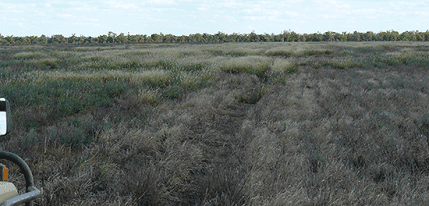SUMMER grass weeds have long been a challenge in the northern grain growing region – a problem complicated by the emergence of glyphosate resistance in key weeds such as awnless barnyard grass, liverseed grass and feathertop Rhodes grass.
Rather than relying solely on a knockdown strategy, growers are increasingly introducing a pre-emergent herbicide in the fallow phase, to assist in tackling these problems.
While Dual Gold had proven in trials to be an effective pre-emergent herbicide option, reducing germination of key grass weeds without significantly impacting on crop rotations, it was difficult to get the application timing right.
Identifying this primary issue led to a meeting between the Grains Research and Development Corporation (GRDC), Syngenta, Northern Grower Alliance (NGA) and ICAN to discuss the need for a Dual Gold label update to provide more options for growers.
Overseas data suggested Dual Gold could be applied over the top of sorghum after crop emergence, but before weed germination.
However, it was not known whether a post-emergent use pattern would be approved in Australia.
This led to a modest co-investment of resources from GRDC for project scoping and to assess crop tolerance, application rates and timing – to ensure residue levels in harvested grain did not exceed the current Australian standards from this late use pattern.
As a result of this joint industry approach, Dual Gold can now be used with greater flexibility.
Key additions to the new label update include:
- Provision for single or split applications in spring/summer fallows;
- The addition of feathertop Rhodes grass control in several use situations;
- The ability to apply Dual Gold up to four weeks prior to planting of Concep II-treated sorghum and then follow with a top-up rate once the crop has emerged.
ICAN senior consultant Mark Congreve said trials over many years had shown that Dual Gold could be effective in reducing germinations of these key grass weeds, without too many crop rotation restrictions.
“Agronomists and growers tell us it can be difficult to get the timing of application right. To be effective Dual Gold needs to be applied before the first spring rainfall and the weed germinations which soon follow,” Mr Congreve said.
“If incorporating rainfall doesn’t occur within seven to 10 days of application, excessive product loss may occur in situations where the herbicide has not been mechanically incorporated. In addition, when applied early in spring it is likely to have run out of residual activity by mid to late summer.”
Mr Congreve said growers had wanted use patterns that would allow for spring applications in fallow while also extending applications later into the sorghum window.
“Having the ability to use a ‘top-up’ application, after the sorghum crop has emerged, allows much greater flexibility in being able to time the applications to suit ‘incorporating’ rainfall, while extending the length of residual control,” he said.
“Having the ability to apply the herbicide earlier in the fallow period and then topping up after crop emergence also means that there is potentially one less spray required during the busy planting window.
“This may lower the risk of damage to sorghum crops, which is most likely to occur from at-planting applications, should conditions become cool and wet during crop emergence.”
Source: GRDC





HAVE YOUR SAY